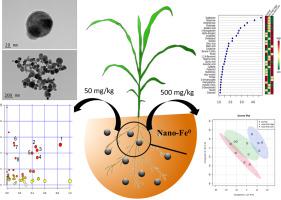NanoImpact ( IF 4.7 ) Pub Date : 2021-06-18 , DOI: 10.1016/j.impact.2021.100336 Yi Wang 1 , Si Chen 2 , Chaoyi Deng 3 , Xiaoxia Shi 2 , Keni Cota-Ruiz 3 , Jason C White 4 , Lijuan Zhao 2 , Jorge L Gardea-Torresdey 3

|
Nanoscale zero-valent iron (nZVI) has been widely applied in the environmental field to degrade organic pollutants. The potential risk posed from nZVI on crop species is not well understood and is critical for sustainable application in the future. In this study, maize (Zea mays L.) plants were cultivated in field soils mixed with nZVI at 0, 50, and 500 mg/kg soil for four weeks. Upon exposure to 500 mg/kg nZVI, ICP-MS results showed that Fe accumulated by roots and translocated to leaves was increased by 36% relative to untreated controls. At 50 mg/kg, root elongation was enhanced by 150–200%; at 500 mg/kg, pigments, lipid peroxidation, and polyphenolic levels in leaves were increased by 12, 87 and 23%, respectively, whereas the accumulation of Al, Ca, and P were decreased by 62.2%, 19.7%, and 13.3%, respectively. A gas chromatography–mass spectrometry (GC–MS) based metabolomics analysis of maize roots revealed that antioxidants and stress signaling-associated metabolites were downregulated at 50 mg/kg, but were upregulated at 500 mg/kg. At 50 mg/kg, the content of glutamate was increased by 11-fold, whereas glutamine was decreased by 99% with respect to controls. Interestingly, eight metabolic pathways were disturbed at 50 mg/kg, but none at 500 mg/kg. This metabolic reprogramming at the lower dose represented potential risks to the health of exposed plants, which could be particularly important although no phenotypic impacts were noted. Overall, metabolites analysis provides a deeper understanding at the molecular level of plant response to nZVI and is a powerful tool for full characterization of risk posed to crop species as part of food safety assessment.
中文翻译:

代谢组学分析揭示了暴露于零价铁纳米颗粒后玉米(Zea mays L.)代谢物和矿物质营养成分的剂量依赖性变化
纳米级零价铁(nZVI)已广泛应用于环境领域以降解有机污染物。nZVI 对作物物种构成的潜在风险尚不清楚,这对于未来的可持续应用至关重要。在本研究中,玉米(Zea maysL.) 植物在田间土壤中与 0、50 和 500 mg/kg 土壤混合的 nZVI 培养 4 周。暴露于 500 mg/kg nZVI 后,ICP-MS 结果表明,相对于未处理的对照,根积累并转移到叶子的 Fe 增加了 36%。在 50 mg/kg 时,根伸长率提高了 150-200%;在 500 mg/kg 时,叶片中的色素、脂质过氧化和多酚水平分别增加了 12%、87% 和 23%,而 Al、Ca 和 P 的积累分别减少了 62.2%、19.7% 和 13.3% , 分别。基于气相色谱-质谱 (GC-MS) 的玉米根代谢组学分析显示,抗氧化剂和应激信号相关代谢物在 50 mg/kg 时下调,但在 500 mg/kg 时上调。在 50 mg/kg 时,谷氨酸的含量增加了 11 倍,而谷氨酰胺相对于对照组减少了 99%。有趣的是,8 种代谢途径在 50 mg/kg 时受到干扰,但在 500 mg/kg 时没有。这种较低剂量的代谢重编程代表了对暴露植物健康的潜在风险,尽管没有注意到表型影响,但这可能特别重要。总体而言,代谢物分析在植物对 nZVI 反应的分子水平上提供了更深入的了解,并且是作为食品安全评估的一部分全面描述作物物种风险的有力工具。尽管没有注意到表型影响,但这可能特别重要。总体而言,代谢物分析在植物对 nZVI 反应的分子水平上提供了更深入的了解,并且是作为食品安全评估的一部分全面描述作物物种风险的有力工具。尽管没有注意到表型影响,但这可能特别重要。总体而言,代谢物分析在植物对 nZVI 反应的分子水平上提供了更深入的了解,并且是作为食品安全评估的一部分全面描述作物物种风险的有力工具。











































 京公网安备 11010802027423号
京公网安备 11010802027423号